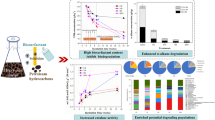Summary
Biosurfactants have potential for use in enhancement of in situ biorestoration by increasing the bioavailability of contaminants. Microorganisms isolated from biostimulated, contaminated and uncontaminated zones at the site of an aviation fuel spill and hydrocarbon-degrading microorganisms isolated from sites contaminated with unleaded gasoline were examined for their abilities to emulsify petroleum hydrocarbons. Emulsifying ability was quantified by a method involving agitation and visual inspection. Biostimulated-zone microbes and hydrocarbon-degrading microorganisms were the best emulsifiers as compared to contaminated and uncontaminated zone microbes. Biostimulation (nutrient and oxygen addition) may have been the dominant factor which selected for and encouraged growth of emulsifiers; exposure to hydrocarbon was also important. Biostimulated microorganisms were better emulsifiers of aviation fuel (the contaminant hydrocarbon) than of heavier hydrocarbon to which they were not previously exposed. By measuring surface tension changes of culture broths, 11 out of 41 emulsifiers tested were identified as possible biosurfactant producers and two isolates produced large surface tension reductions indicating the high probability of biosurfactant production.
Similar content being viewed by others
References
Atlas, R.M. 1984. Use of microbial diversity measurements to assess environmental stress. In: Current Perspectives in Microbial Ecology (Klug, M.J. and C.A. Reddy, eds.) pp. 540–545, American Society for Microbiology. Washington, DC.
Balkwill, D.L. 1990. Deep-aquifer microorganisms. In: Isolation of Biotechnological Organisms from Nature (Labeda, D.P., ed.) pp. 184–211, McGraw-Hill, New York, NY.
Bannerjee, S., S. Duttagupta and A.M. Chakrabarty. 1983. Production of emulsifying agent during growth ofPseudomonas cepacia with 2,4,5-trichlorophenoxyacetic acid. Arch. Microbiol. 135: 110–114.
Broderick, L.S. and J.J. Cooney. 1979. Emulsification of hydrocarbons by bacteria from freshwater ecosystems. Dev. Industr. Microbiol. 24: 425–434.
Cook, F.D. and D.W.S. Westlake. 1974. Microbiological degradation of northern crude oils. In: Environmental-Social Committee: Northern Pipelines, Task Force on Northern Oil Development. Information Canada, Report No. 74-1, Catalog No. R72-12774. Ottawa, Canada.
Cooper, D.G. 1986. Biosurfactants. Microbiol. Sci. 3: 145–149.
Cooper, D.G., C.R. McDonald, S.J.B. Duff and N. Kosaric. 1981. Enhanced production of surfactin fromBacillus subtilus by continuous removal and metal cation additions. Appl. Environ. Microbiol. 42: 408–412.
Dunlap, W.J., J.F. McNabb, M.R. Scalf and R.L. Cosby. 1977. Sampling for organic chemicals and microorganisms in the subsurface. EPA 600/2-77-176, U.S. Environmental Protection Agency, Ada, OK.
Duvnjak, Z., D.G. Cooper and N. Kosaric. 1983. Effect of nitrogen sources on surfactant production byArthrobacter paraffineus. In: Microbial Enhanced Oil Recovery (Zajic, J.E., D.G. Cooper, T.R. Jack and N. Kosaric, eds.) pp. 66–72, Pennwell Books, Tulsa, OK.
Fiorenza, S. 1990. Personal communication. Rice University, Houston, TX.
Gerson, D.F. and J.E. Zajic. 1978. Surfactant production from hydrocarbons byCorynebacterium lepus andPseudomonas asphaltericus. Dev. Industr. Microbiol. 19: 577–599.
Gerson, D.F. and J.E. Zajic. 1979. Comparison of surfactant production from kerosene by four species of Corynebacterium. Antonie van Leeuwenhoek 45: 81–94.
Ghiorse, W.C. and J.T. Wilson. 1988. Microbial Ecology of the Terrestrial Subsurface. Adv. Appl. Microbiol. 33: 107–172.
Guerra-Santos, L.H., O. Kappelli and A. Geichter. 1986. Dependence ofPseudomonas aeruginosa continuous culture biosurfactant production on nutritional and environmental factors. Appl. Microbiol. Biotech. 24: 443–448.
Knetting, E. and J.E. Zajic. 1972. Flocculant production from kerosene. Biotech. Bioeng. 14: 179–390.
Neufeld, R.J., J.E. Zajic and D.F. Gerson. 1983. Growth characteristics and cell partitioning ofAcinetobacter on hydrocarbon substrates. J. Ferment. Technol. 61: 315–321.
Raymond, R.L. 1974. Reclamation of Hydrocarbon Contaminated Ground Waters. U.S. Patent No. 3,846,290. November 5, 1974.
Raymond, R.L., R.A. Brown, R.D. Norris and E.T. O'Neill. 1986. Stimulation of Biooxidation Precesses in Subterranean Formations. U.S. Patent 4,588,506. May 13, 1986.
Roy, P.D., H.D. Singh, S.D. Bhagat and J.N. Baruah. 1979. Characterization of hydrocarbon emulsification and solubilization occurring during growth ofEndomycopis lipolytica on hydrocarbon. Biotech. Bioeng. 21: 955–974.
Syldatk, C. and F. Wagner. 1987. Production of biosurfactants. In: Biosurfactants and Biotechnology (Kosaric, N. and W.L. Cairns, eds.) pp. 89–121, Marcel Dekker, New York, NY.
Texas Research Institute. 1982. Enhancing the microbial degradation of underground gasoline by increasing available oxygen. pp. 1–25, American Petroleum Institute Document 8081 (FR). WLW. Washington, D.C.
Ward, C.H., J.M. Thomas, S. Fiorenza, H.S. Rifai, P.B. Bedient, J.M. Armstrong, J.T. Wilson and R.L. Raymond. 1988. A quantitative demonstration of the Raymond process for in situ biorestoration of contaminated aquifers. In: Proceedings, NWWA/API Conference on Petroleum Hydrocarbons and Organic Chemicals in Ground Water: Prevention, Detection and Restoration, pp. 723–741, Houston, TX.
Wilson, J.T., J.R. McNabb, B.H. Wilson and M.L. Noohan. 1983. Biotransformation of selected organic pollutants in ground water. Dev. Industr. Microbiol. 24: 225–233.
Zajic, J.E. and C.J. Panchal. 1976. Bioemulsifiers. CRC Crit. Rev. Micro. 5: 39–66.
Zajic, J.E. and W. Seffens. 1984. Biosurfactants. CRC Crit. Rev. Biotech. 1: 87–107.
Ziegenfuss, S. 1987. The potential use of surfactant and cosolvent soil washing as adjuvant for in situ aquifer restoration. 78 pp., Master's Thesis, Rice University, Houston, TX.
Author information
Authors and Affiliations
Rights and permissions
About this article
Cite this article
Francy, D.S., Thomas, J.M., Raymond, R.L. et al. Emulsification of hydrocarbons by subsurface bacteria. Journal of Industrial Microbiology 8, 237–245 (1991). https://doi.org/10.1007/BF01576061
Received:
Accepted:
Issue Date:
DOI: https://doi.org/10.1007/BF01576061




